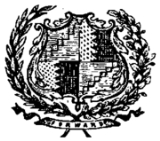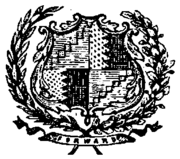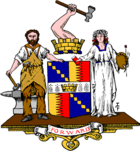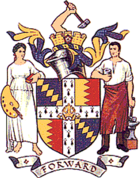
Coat of arms of Birmingham
Encyclopedia
The coat of arms of Birmingham is the heraldic emblem
of the English city of Birmingham
. It was first used in 1838 and has been changed several times since, as the former town
grew and developed into a city
.
 Following the incorporation of Birmingham as a borough
Following the incorporation of Birmingham as a borough
in 1838, the corporation approved the design of a seal comprising "The Birmingham Arms, encircled with a wreath", with the motto "Forward". The arms were those used from about 1413 to 1536 by the de Bermingham family
, holders of the manor.
The quartered shield featured in the first and fourth quarters five gold lozenges or diamond shapes conjoined in a diagonal "bend". These were the original arms of the de Berminghams until about 1343. The second and third quarters were divided vertically with an "indented" line. This should have been coloured in black and white, but in the version adopted by the corporation it was coloured gold and red. These were in fact the arms of another branch of the family , who became the Barons of Athenry
and Earls of Louth
in Ireland
. In 1867 a new seal was made, and at the time the discrepancy in the colouring of the second and third quarters was noticed. However, it was decided to retain the colouring.
 In 1889 Birmingham was granted city status, and to celebrate this fact, the corporation applied to the College of Arms
In 1889 Birmingham was granted city status, and to celebrate this fact, the corporation applied to the College of Arms
for a grant of supporters to the arms. It was then realised that the arms used by Birmingham had never been officially granted, so a full grant of arms, crest and supporters was obtained in April of that year.
The shield was altered, with the addition of an ermine fess or horizontal band across the centre. This comes from the arms of the Calthorpe family
, Lords of the Manor of Edgbaston
, an area included in the borough at its incorporation. A mural crown - resembling a city wall - was placed on the fess to represent local government. The crest consisted of a man's arm holding a hammer, symbolising industry. The supporters were two human figures: a male figure (dressed as a blacksmith) representing industry and a female figure (holding a book and painter's palette) representing art.
.
As there were doubts about the heraldic correctness of the new design, a new painting was obtained from the College of Arms
in 1936 incorporating the changes, but still conforming to the 1889 blazon or technical description. The main changes were the addition of a helm and mantling between the shield and crest, a redrawing of the male figure and the replacement of the platform on which the supporters stood with a grassy compartment.
These arms continued in use until the abolition of the corporation.
 A new City of Birmingham was created, including the old city and the former borough of Sutton Coldfield
A new City of Birmingham was created, including the old city and the former borough of Sutton Coldfield
in 1974. New arms were granted to Birmingham City Council in 1977, closely based on the old arms. Instead of the ermine fess a cross was introduced, charged with a bishop's mitre. These come from the Sutton Coldfield corporation arms and commemorate Bishop Vesey of Exeter
, a native of Sutton, who was largely responsible for the growth of the town in the 16th century. A Tudor
rose was added to the 1889 crest. This was the device of Sutton Coldfield from at least 1619 until 1935. As the College of Arms does not allow two bodies or persons to have identical supporters, they were swapped to opposite sides of the shield. The male figure now holds a cupel
, a tool used in the manufacture of jewellery, an important industry in modern Birmingham.
, refuse collection vehicles, and even the crockery and cutlery used in the Council House.
A banner of the arms is used as the flag of Birmingham.
Coat of arms
A coat of arms is a unique heraldic design on a shield or escutcheon or on a surcoat or tabard used to cover and protect armour and to identify the wearer. Thus the term is often stated as "coat-armour", because it was anciently displayed on the front of a coat of cloth...
of the English city of Birmingham
Birmingham
Birmingham is a city and metropolitan borough in the West Midlands of England. It is the most populous British city outside the capital London, with a population of 1,036,900 , and lies at the heart of the West Midlands conurbation, the second most populous urban area in the United Kingdom with a...
. It was first used in 1838 and has been changed several times since, as the former town
Town
A town is a human settlement larger than a village but smaller than a city. The size a settlement must be in order to be called a "town" varies considerably in different parts of the world, so that, for example, many American "small towns" seem to British people to be no more than villages, while...
grew and developed into a city
City
A city is a relatively large and permanent settlement. Although there is no agreement on how a city is distinguished from a town within general English language meanings, many cities have a particular administrative, legal, or historical status based on local law.For example, in the U.S...
.
Incorporation

Borough
A borough is an administrative division in various countries. In principle, the term borough designates a self-governing township although, in practice, official use of the term varies widely....
in 1838, the corporation approved the design of a seal comprising "The Birmingham Arms, encircled with a wreath", with the motto "Forward". The arms were those used from about 1413 to 1536 by the de Bermingham family
De Birmingham family
The de Birmingham family held the lordship of Birmingham in England for four hundred years and managed its growth from a small village into a thriving market town. They also helped invade Ireland and were rewarded with the Barony of Athenry...
, holders of the manor.
The quartered shield featured in the first and fourth quarters five gold lozenges or diamond shapes conjoined in a diagonal "bend". These were the original arms of the de Berminghams until about 1343. The second and third quarters were divided vertically with an "indented" line. This should have been coloured in black and white, but in the version adopted by the corporation it was coloured gold and red. These were in fact the arms of another branch of the family , who became the Barons of Athenry
Athenry
Athenry is a town in County Galway, Ireland. It lies east of Galway city, and one of the attractions of the town is its medieval castle. The town is also well-known by virtue of the song "The Fields of Athenry".-History:...
and Earls of Louth
County Louth
County Louth is a county of Ireland. It is part of the Border Region and is also located in the province of Leinster. It is named after the town of Louth. Louth County Council is the local authority for the county...
in Ireland
Ireland
Ireland is an island to the northwest of continental Europe. It is the third-largest island in Europe and the twentieth-largest island on Earth...
. In 1867 a new seal was made, and at the time the discrepancy in the colouring of the second and third quarters was noticed. However, it was decided to retain the colouring.
City Status

College of Arms
The College of Arms, or Heralds’ College, is an office regulating heraldry and granting new armorial bearings for England, Wales and Northern Ireland...
for a grant of supporters to the arms. It was then realised that the arms used by Birmingham had never been officially granted, so a full grant of arms, crest and supporters was obtained in April of that year.
The shield was altered, with the addition of an ermine fess or horizontal band across the centre. This comes from the arms of the Calthorpe family
Gough-Calthorpe family
The Gough-Calthorpe family is descended from ancient and notable families who both held lands in the area around Birmingham, England.Sir Henry Gough, 1st Baronet, Member of Parliament, was made a Baronet in the Baronetage of the United Kingdom in 1728...
, Lords of the Manor of Edgbaston
Edgbaston
Edgbaston is an area in the city of Birmingham in England. It is also a formal district, managed by its own district committee. The constituency includes the smaller Edgbaston ward and the wards of Bartley Green, Harborne and Quinton....
, an area included in the borough at its incorporation. A mural crown - resembling a city wall - was placed on the fess to represent local government. The crest consisted of a man's arm holding a hammer, symbolising industry. The supporters were two human figures: a male figure (dressed as a blacksmith) representing industry and a female figure (holding a book and painter's palette) representing art.
Modernisation
By 1930 the city corporation felt that the design looked too old fashioned and adopted a new depiction designed by the Birmingham School of ArtBirmingham School of Art
The Birmingham School of Art was a municipal art school based in the centre of Birmingham, England. Although the organisation was absorbed by Birmingham Polytechnic in 1971 and is now part of Birmingham City University's Birmingham Institute of Art and Design, its Grade I listed building on...
.
As there were doubts about the heraldic correctness of the new design, a new painting was obtained from the College of Arms
College of Arms
The College of Arms, or Heralds’ College, is an office regulating heraldry and granting new armorial bearings for England, Wales and Northern Ireland...
in 1936 incorporating the changes, but still conforming to the 1889 blazon or technical description. The main changes were the addition of a helm and mantling between the shield and crest, a redrawing of the male figure and the replacement of the platform on which the supporters stood with a grassy compartment.
These arms continued in use until the abolition of the corporation.
Current

Sutton Coldfield
Sutton Coldfield is a suburb of Birmingham, in the West Midlands of England. Sutton is located about from central Birmingham but has borders with Erdington and Kingstanding. Sutton is in the northeast of Birmingham, with a population of 105,000 recorded in the 2001 census...
in 1974. New arms were granted to Birmingham City Council in 1977, closely based on the old arms. Instead of the ermine fess a cross was introduced, charged with a bishop's mitre. These come from the Sutton Coldfield corporation arms and commemorate Bishop Vesey of Exeter
John Vesey
John Vesey or Veysey was an English bishop.-Life:He was born John Harman, probably about 1462, the son of a yeoman farmer, in a farmhouse now known as Moor Hall Farm, Sutton Coldfield...
, a native of Sutton, who was largely responsible for the growth of the town in the 16th century. A Tudor
Tudor dynasty
The Tudor dynasty or House of Tudor was a European royal house of Welsh origin that ruled the Kingdom of England and its realms, including the Lordship of Ireland, later the Kingdom of Ireland, from 1485 until 1603. Its first monarch was Henry Tudor, a descendant through his mother of a legitimised...
rose was added to the 1889 crest. This was the device of Sutton Coldfield from at least 1619 until 1935. As the College of Arms does not allow two bodies or persons to have identical supporters, they were swapped to opposite sides of the shield. The male figure now holds a cupel
Cupel
Cupel may refer to:*A porous pot used in cupellation*Cupel, Białobrzegi County in Masovian Voivodeship *Cupel, Legionowo County in Masovian Voivodeship...
, a tool used in the manufacture of jewellery, an important industry in modern Birmingham.
Use
As well as its use on seals and letters, the coat of arms is used in a number of ways, for example as an architectural detail, or to decorate items including buses (in the days when municipal transport was the responsibility of the council), street furnitureStreet furniture
Street furniture is a collective term for objects and pieces of equipment installed on streets and roads for various purposes, including traffic barriers,...
, refuse collection vehicles, and even the crockery and cutlery used in the Council House.
A banner of the arms is used as the flag of Birmingham.

